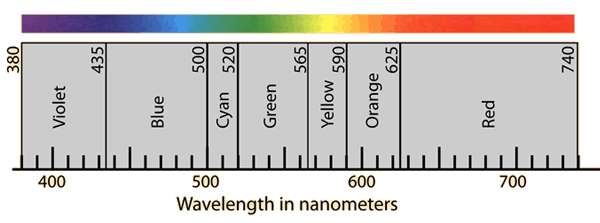If we were shown a color wheel and were asked to name the colors, I am sure most of us would be able to name each one, excluding those of us with vision deficiencies. But in the end these are just names. Do we all see the same colors as everyone else? What if I look up and exclaim “The sky is blue”? People would agree that the sky is blue, but what if what is blue to me is yellow or orange to someone else?
A first step into trying to answer this question is knowing how humans can see color. Stephanie Pappas has put together a very interesting page on livescience.com that makes this a little bit easier to understand. On the webpage Pappas describes, “When light hits an object – say, a banana – the object absorbs some of the light and reflects the rest of it” (Pappas). The waves of light from the sun project the color onto our eyes and into our minds based on the different types of wavelengths that reach us.
This picture is a good representation of the varying wavelengths in which we see different colors.
 One aspect of this question that is important to consider is colorblindness. Tom Stafford writing for the BBC explained the differences between “normal-sighted” and colorblinded people by saying, “They [colorblind people] live among the colour-seeing, getting by on the fact that there is usually some other difference between things of different colours that they can use to tell them apart, such as differences in shade or texture”. Humans have the ability to see different shades and tones of color by the way the light waves hit their eyes similar to the example above. So, shouldn’t this ability be able to be applied to color as well?
One aspect of this question that is important to consider is colorblindness. Tom Stafford writing for the BBC explained the differences between “normal-sighted” and colorblinded people by saying, “They [colorblind people] live among the colour-seeing, getting by on the fact that there is usually some other difference between things of different colours that they can use to tell them apart, such as differences in shade or texture”. Humans have the ability to see different shades and tones of color by the way the light waves hit their eyes similar to the example above. So, shouldn’t this ability be able to be applied to color as well?
An experiment involving colorblind monkeys may have some significance. Maureen and Jay Neitz, through using gene therapy and surgery, were able to make colorblind monkeys react to color as if they have always been able to see it. You can view the results in the video below posted by USA Today.
Humans and monkeys are very similar in genetic makeup so it is plausible that a similar approach used on humans would yield some results about the perception of color. But as is mentioned up in the video, it is not very practical in this form to subject humans to.
We also have to consider what is objective and subjective in answering this question. This is detailed on a webpage on scienceline.ucsb.edu stating, “the physical properties of light may be objective (measurable) but the names we give the light we see (e.g., “color”) are entirely subjective”. This being the case, we all reference the colors by name. But if the names and how we classify the colors are subjective, then answering if we see the “same” colors becomes a little muddier.
In conclusion, I am not really sure if we see the same colors. There seems to be a lot of information above that could be considered promising, and also inconclusive. The monkey experiment draws a familiar connection to something we discussed in class. Andrew talked about how animal experiments are specific to the animals and they take a long time to conduct. But the results of the monkey experiment clearly show the monkeys are responding to color. Many factors go into answering this question, and it may be a question we can never answer because we cannot possibly know how or what the people around us perceive.

I found your post and your research to be extremely interesting! While I am not colorblind, I do know a few people who are and I always found it to be a bit odd. How can he not see green? Why can she not see the color red? Colorblindness always intrigued me. I have noticed recently that many people see different shades of colors differently. For example, my boyfriend and I often argue about what color something is. For some shades of purple, he sees them as blue, and I see them as purple. The same thing goes for oranges. Often, I will see things as pink, but he thinks they are orange. These little differences make me wonder how differently others see the world, compared to my own viewpoint.
I always wondered if we all see the same colors as well. It was neat to see some of the scientific research behind this as well. However, I think this would be almost impossible to prove either way because we will never be able to physically see through another person’s eyes and thoughts. (Not yet anyway!) I also wondered how we can say that someone who is “colorblind” is wrong when we do not actually know if their way of seeing colors is “wrong” or just the minority. Interesting post!